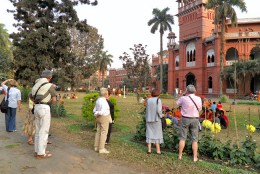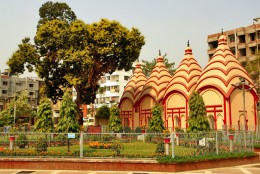Curzon Hall This structure was built in 1904. Meant to be a town hall and was named after Lord Curzon, the then British Viceroy in India. It was used as such till 1911, when the partition of Bengal was annulled. Following the annulment of partition in 1911 it was used as a premise of Dhaka College, and after the establishment of Dhaka University in 1921, became part of the university's science section and continues as such.
The building has a happy blend of European and Mughal elements, particularly noticeable in the projecting facade in the north which has both horse-shoe and cusped arches. The style combined traditional art with modern technology and functions and favoured Mughal forms such as arches and domes, believed to have entered the Islamic world from the west.
Language Martyrs’ Memorial ‘Shahid Minar’ in Bangla, was built in the memory of the martyrs who were killed in the 21st February of 1952 during the Language Movement of Bangladesh, then East Pakistan. Language Movement, being the first ever revolt against then Pakistani rulers, is a symbol of our courage and dignity and hence the memorial is of high significance to our society and life.
Dhakeshwari TempleThe Dhakeshwari temple was built in the 12th century by Ballal Sena, a king of the Sena Dynasty, and many say the name of the city was coined after this temple. This is a complex of several temples and ancillary buildings. The main temple is situated in the inner quarter on the east. A wall separates this quarter from the outer wall and entered through a monumental gateway, a bell adorns its top. The female deity has got the epithet dhakeshwari as the patron deity of the city of Dhaka (dhaka + ishvari).
Lalbagh FortLalbagh Fort is an incomplete Mughal palace fortress at Dhaka on the river Buriganga. The river has now gone further south and flows at quite a distance from the fort. The construction of the fort was commenced in 1678 AD by Prince Muhammad Azam and was left unfinished since 1684. At the centre of the fort stands the Tomb of Pari Bibi, the beloved daughter of Shaista Khan. On the western side of the tomb stands the Mosque and the Diwaan-e-aam along with the hummam khana is in the east. The fort has a huge tank and residence for the soldiers and officials in the inner side of the southern wall.
Buriganga RiverBuriganga is a very small river of only 27 km long. On average the river is 400m wide and 10m deep. It is a tributary of the mighty Brahmaputra River, which is called Jamuna in Bangladesh. Dhaka, the capital city of Bangladesh is situated by this river. Majority of the water transports linking Dhaka to the southern part of Bangladesh use this river. Sadarghat is the main terminal, while Damra is also used for minor purposes.
National Parliament BuildingBangladesh National Parliament Building is one of Luis I Kahn's master creations. Some says this is one of the most significant monumental buildings in the history of mankind. The construction began in 1964, and with a gap during the independence war in 1971, it was completed in the 1982.








